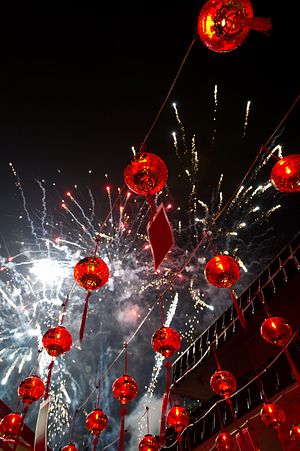Not very surprisingly, the total number of passenger trips for China’s chunyun (the Spring Festival travel rush) in 2014 will set a new record – 3.62 billion, according to Lian Weiliang, deputy head of the National Development and Reform Commission (NDRC). During the 40-day travel rush, millions of Chinese people will first travel home and then return, making chunyun annually the biggest short-term migration phenomenon in human history.
However far, however exhausting the travel will be, and despite the various inconveniences they might meet on their journeys, people are rushing back to their hometowns, where they long to find warmth, comfort, and simply a sense of being together – a family reunion. For Chinese people, who are going through a massive process of modernization and globalization, traditional values are in some ways becoming more popular. Although many young Chinese in big cities celebrate the Western Christmas holiday, chunjie (usually translated as Spring Festival or Chinese New Year) still keeps its premier status and even takes on more traditional colors.
For example, national or provincial Spring Festival ceremonies are becoming more frequent in recent years. Well-educated younger generations are also becoming more actively involved in family Spring Festival worship and rituals— it is young Chinese who are enthusiastically discussing the revival of Hanfu (traditional Han Chinese clothing perfected and popularized during the Han Dynasty, 206 BCE – 220 CE) and holding many Hanfu related activities and ceremonies throughout university campuses.
Another interesting phenomenon are the new terms being coined using the symbol of the horse (the sign for this year according to the Chinese zodiac). Chinese language is the oldest continuously used system of writing in the world, a source of great pride for Chinese people. Yet the language also subtly reflects economic and social changes in contemporary China. In the Chinese language itself, tradition and innovation combine in surprising ways.
Entering 2014, the digital world has helped create and popularize a sequence of new terms beginning with character for horse ma (马 in Chinese). The flexibility of digital media allows pictures to combine with language to create visual puns. For example, an image of a horse carrying a wad of cash on its back can be described as 马上(ma shang, “on horseback”) 有钱 (you qian, literally “there is money,” but more common used to mean “to be rich”). In Chinese, ma shang (“on horseback”) has the additional meaning of “immediately.” Thus, the image of a horse loaded with cash means “getting rich immediately” through a combination of the literal and figurative meanings of Chinese phrases.
Another example: a pair of elephants on horseback means “getting a boyfriend/girlfriend immediately.” In Chinese “a pair of elephants” can be translated as 对象 (dui xiang), which also happens to mean romantic partners. Actually, in Chinese traditional culture, we can find similar combinations of characters quite often, going back to the Han Dynasty. The internet age simply provides another medium to use in playing with China’s ancient language.
Even while remaining traditional, chunjie is also getting more international. According to Xinhua, a total number of 506 “Happy Spring Festival” activities will be held in 294 cities in 103 countries and regions. Top world leaders also extend their Spring Festival greetings to Chinese people.
Of course, one of the main drivers for the internationalization of chunjie comes from China’s status as a rising economic great power and the opportunities in China’s huge market. For example, in his Spring Festival greetings [Chinese], UK Prime Minister David Cameron extended his warm greetings to Chinese people around the world, and he did not miss an opportunity to highlight the importance of economic cooperation as one of the foundations for China-UK relations. Also, despite the current ongoing Sino-Japanese standoff, Japanese Prime Minister Shinzo Abe extended his Spring Festival greetings [Chinese] to Chinese people who live in Japan. Abe restated the importance of economic relations between these two countries, and particularly highlighted this year’s symbol of “horse.” At the end of his greetings, Abe suggested both countries should cross barriers and move forward together for the future.
The overseas Spring Festival activities and celebrations can be regarded as a product of China’s growing share in the world economy and its recognition by the international community. But Spring Festival as a cultural paradigm is going through a series of changes. A commentary in the USChinaPress [Chinese] contrasted Spring Festival with the globalization of Christmas. The spread of Christmas, the article argued, happened after Western nations had completed modernization. By contrast, Chinese Spring Festival (and the Chinese society in which chunjie is rooted) are still in the process of transformation. As some of the traditional Spring Festival elements are being lost, others are being regained by Chinese society. It brings to mind a claim by Lu Xun, the leading figure of Chinese modern literature, that things can only be international by truly bearing national characteristics.

































